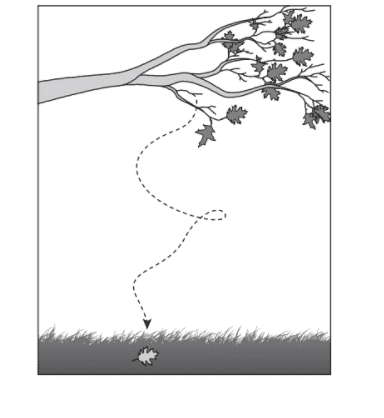
TEKS Grade 8 Science - 8.6 Diagnostic - Force, Motion and Energy
Quiz by Grade 8 Science - Texas Education Agency
Grade 8
Science (2017)
Texas Essential Knowledge and Skills (TEKS)
Feel free to use or edit a copy
includes Teacher and Student dashboards
Measures 3 skills from
Measures 3 skills from
With a free account, teachers can
- edit the questions
- save a copy for later
- start a class game
- automatically assign follow-up activities based on students’ scores
- assign as homework
- share a link with colleagues
- print as a bubble sheet
10 questions
Show answers
- Q1A leaf fell from a tree branch. The path it followed is shown in the diagram. Which of these best describes why the leaf fell in a crooked path instead of straight down?Objects with irregular shapes never fall in straight lines.Air currents and gravity applied changing and unbalanced forces to the leaf.The upward force of the air on the leaf was greater than the downward force of gravity.Once the leaf was in motion, it continued moving in the same direction because the forces were balanced.30s8.6a
- Q2The diagram shows a homemade car being pushed with a force of 25 N. The force causes the car to move at a constant speed of 3 m/s. What will happen if the force is changed to 35 N?The car will move at a constant speed of 13 m/s.The speed of the car will increase.The speed of the car will decrease to 1 m/s.The speed of the car will not change.30s8.6a
- Q3Two students are working together to build a birdhouse. Student 1 applies a force of 10 N to a wooden board in order to slide it across the table to Student 2. If the force of friction resisting the student’s push is 4 N, what is the net force acting on the board?10 N4N6N14 N30s8.6a
- Q4The three vehicles shown are all traveling at a speed of 15 m/s, but only the pickup truck has a changing velocity. The pickup truck has a changing velocity because the pickup truck —needs a large amount of force to moveis traveling on a curve in the roadcan accelerate faster than the other two vehiclesis traveling in the opposite direction from the other two vehicles30s8.6b
- Q5Which of the following best describes the velocity of an object?30 m/s30 m east30 m/s east30s8.6b
- Q6A student graphed the position of a cart during a 7-second time interval. Which statement best describes the cart?The cart accelerated at a constant rate of approximately 0.8 m/s2 .The cart was stationary except for a short burst of acceleration of 0.5 m/s2 .The cart was stationary with a velocity of 0 m/s for the entire 7 seconds.The cart moved at a constant velocity of 0.5 m/s for the entire 7 seconds.30s8.6b
- Q7Two cars with different masses travel at the same speed down a hill toward a stop sign. What will happen when both cars apply brakes at the same time to stop?The car with the larger mass will maintain its velocity while traveling down the hill.The car with the smaller mass will require less force to stop than the car with the larger mass.The car with the larger mass will have less inertia than the car with the smaller mass.The car with the smaller mass will take longer to stop than the car with the larger mass.30s8.6c
- Q8Sometimes tectonic plates do not move easily past one another, and the plates become stuck. Forces build up, and when the plates finally move, tension is released, as shown below. The sudden movement of the plates is caused by —the weight of the platesunbalanced forcesthe mass of the platesgravitational force30s8.6c
- Q9During a demonstration of Newton’s laws of motion, a student used the setup shown in Figure 1. The student flicked the index card with a fingertip, and the coin fell straight down into a plastic cup as shown in Figure 2. Which of these best explains why the coin fell straight down into the cup instead of remaining on the index card?The acceleration of the coin falling into the cup was equal and opposite to the acceleration of the card.The card had less mass than the coin, so a smaller force of gravity acted on the card. The larger force of gravity on the coin made it fall.The coin was at rest until the card was removed, so it tended to remain in the same location. Once the card was gone, the unbalanced force of gravity caused the coin to fall.Moving the card applied an action force on the coin. Since the card was gone, gravity applied a reaction force on the coin.30s8.6c
- Q10A student jumps off a sled toward the west after it stops at the bottom of an icy hill. Based on the law of action–reaction, in what direction will the sled most likely move as the student jumps off?WestSouthEastNorth30s8.6c
